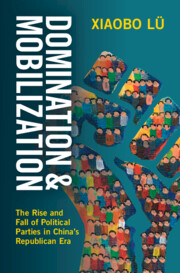Book contents
- Domination and Mobilization
- Domination and Mobilization
- Copyright page
- Dedication
- Contents
- Figures
- Tables
- Acknowledgments
- 1 The Reversal of Fortune of Revolutionary Parties
- 2 A Theory of Party Building by Revolutionary Parties
- 3 Prewar Resource Mobilization (1921–1937)
- 4 Reversal of Fortune
- 5 The CCP
- 6 Mao’s Rise and the Birth of a Strong Party (1935–1945)
- 7 The KMT
- 8 The Legacies of Party Building in China and Beyond
- Appendices
- References
- Index
2 - A Theory of Party Building by Revolutionary Parties
Published online by Cambridge University Press: 11 June 2025
- Domination and Mobilization
- Domination and Mobilization
- Copyright page
- Dedication
- Contents
- Figures
- Tables
- Acknowledgments
- 1 The Reversal of Fortune of Revolutionary Parties
- 2 A Theory of Party Building by Revolutionary Parties
- 3 Prewar Resource Mobilization (1921–1937)
- 4 Reversal of Fortune
- 5 The CCP
- 6 Mao’s Rise and the Birth of a Strong Party (1935–1945)
- 7 The KMT
- 8 The Legacies of Party Building in China and Beyond
- Appendices
- References
- Index
Summary
I present a theoretical framework underscoring the way the emergence of a dominant party leader shapes strategic interactions among party elites, which in turn lead to distinct party-building strategies and capacities for resource mobilization. The key insights of the theoretical framework are threefold. First, party ideology serves as a constraining device influencing the types of party mobilization infrastructure – elite-centric vis-à-vis mass-centric – that embody distinct comparative advantages. Second, domination by a party leader mitigates the collective action problem faced by party elites, leading to coherent party-building strategies that serve as the foundation for effective resource mobilization. In contrast, when party elites engage in contentious power struggles, the quality of mobilization infrastructure suffers because of conflicting party-building strategies. Finally, I integrate the concept of contingencies into the theoretical framework, positing that the balance of intraparty elite power and the state of mobilization infrastructure act as mediators through which these events influence party strength.
Information
- Type
- Chapter
- Information
- Domination and MobilizationThe Rise and Fall of Political Parties in China's Republican Era, pp. 31 - 54Publisher: Cambridge University PressPrint publication year: 2025
